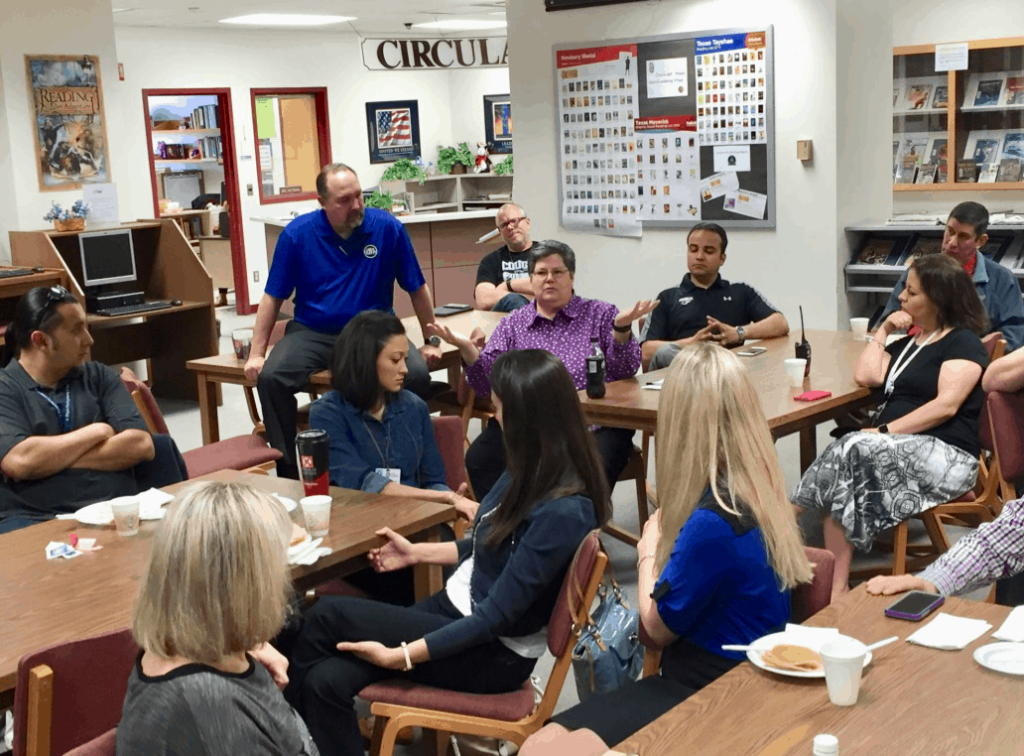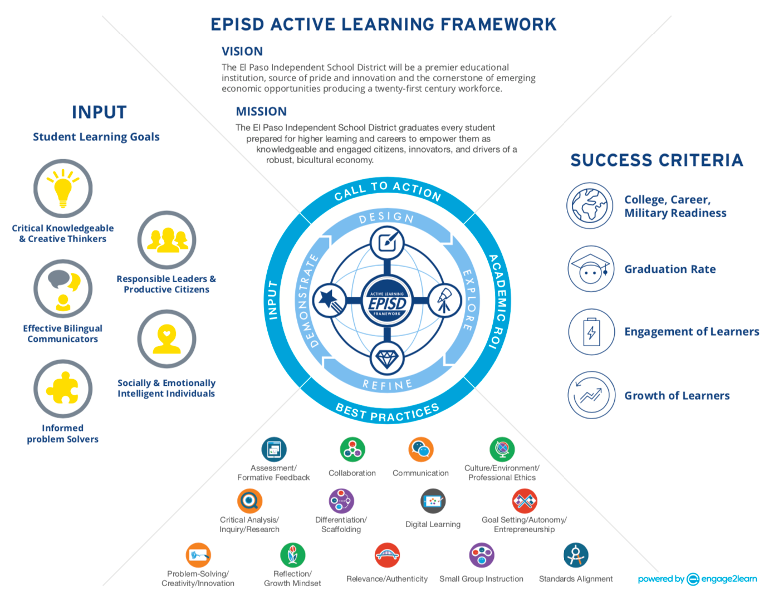Scaling Active Learning: Professional Development Was Key to the El Paso Transformation

By: Shannon Buerk
On the relatively smooth transition to remote learning, “The most important factor was the active learning training for 4,000 El Paso teachers,” said Juan Cabrera, superintendent of El Paso Independent School District (EPISD).
For the last five years, EPISD has been laser-focused on a districtwide rollout of active learning, which serendipitously preceded this past spring’s unexpected turn of events. Through the relentless and wholesale implementation of the Active Learning Framework (ALF), SEL, and digital equity—powered by an investment in job-embedded coaching for every El Paso ISD educator—the ‘pain’ of transformation was spread over time.
That effort might seem like a major undertaking in itself. Now consider this undertaking in the context of 55,000 K-12 students distributed across 86 campuses. Imagine being at the helm of a large, multicultural urban school district. The challenges are many: socioeconomic, linguistic, neurodivergent. What logistical steps would be necessary to ensure a successful transition to active learning?
The leadership and staff of El Paso Independent School District (EPISD) navigated such a transition in these circumstances. When Cabrera was appointed to the role of superintendent in 2013, he arrived at a district in crisis. He immediately focused on laying the foundation for a different future. As part of the EPISD 2020 Strategic Plan, which initiated the shift to active learning, his team held town hall meetings to uncover a ‘graduate profile’—precisely what EPISD students should be able to know and do when they cross the stage at their high school graduation.
The response: “We want graduates to be creative problem solvers.”
Based on the feedback from these early community conversations, EPISD leadership defined five distinct goals that serve as pillars of their graduate profile.
Connecting the dots between articulating these goals and successfully implementing a new model in thousands of classrooms necessitated a strong partnership and that partner ended up being engage2learn. In 2015, I met Superintendent Cabrera, and he discussed the vision for active learning from the community, their Board of Trustees, and the district itself. Scaling any initiative successfully involves building internal capacity, and the processes that underpin it. e2L has experience in this area, and believed we could assist in accelerating their vision into a reality for every learner in El Paso. Our resulting partnership generated an inspirational plan for implementation:
- Design a framework for Active Learning.
- Develop a five-year responsible rollout plan.
- Provide training and job-embedded coaching for every EPISD educator.
Together, we worked to assemble a design team of representatives from every district department. These EPISD staff members streamlined all of their initiatives into a single, unique learning framework suited for every El Paso ISD student. The EPISD Active Learning Framework was born.

Planning efforts were thorough to ensure that the ALF was the one thing that would integrate all of the district initiatives, provide the opportunity for students to acquire the Student Learning Outcomes in EPISD 2020, would be built on e2L Best Practices for student achievement and would result in the engagement, growth and college and career readiness that all EPISD students deserve. However, in many ways, the work had only just begun. Here’s how we partnered with EPISD’s leadership to put active learning into practice.
Professional Development as a Cultural Catalyst
Cabrera and his team sought to change the El Paso learner experience through a massive talent transformation. They understood that building internal capacity and investing in enhancing the craft of the educators in their district would be paramount to this effort.
They crafted a Responsible Rollout Plan, but needed a way to support teachers, instructional coaches and leaders through its implementation. During the design of the district’s ALF, EPISD leaders recognized that one-time professional development wouldn’t usher in the intended change in classroom practices. As a result, Cabrera and his team invested in job-embedded coaching for all of the EPISD teachers and campus leaders through e2L.
They also invested in coaching active learning leaders, to build internal capacity that would support the framework’s implementation for years after our partnership had concluded. Following E.M. Rogers’ Diffusion of Innovation Theory, we devised a five-year plan to support EPISD teachers and campus leaders in making the transition to the Active Learning Framework through a massive professional learning effort, in which two feeder patterns of campuses (approximately 1,000 teachers per year) received training and seven sessions of individualized, job-embedded coaching to implement the EPISD ALF as the instructional model in every classroom.
As illustrated below, the majority of the coaching shifted through a gradual release process so that EPISD’s own active learning leaders coached teachers in the 2018-2019 school year.

Positive student outcomes were visible early on. In 2016—the first year of the framework implementation—learner engagement increased and there was a double-digit difference in standardized test scores in active learning classrooms. In year two, the framework feeder patterns showed enough growth that the overall district scores trend turned positive, and EPISD received the third most distinctions in the state of Texas.
This student growth was due to every teacher, leader, and mentor receiving training and individualized coaching to create an equity of learner experience districtwide. Teachers are growing in the e2L Life Ready Best Practices, which in return promotes student growth in academic and life ready skills.
Crystal Johnston, an EPISD mentor, believed that the program had a significant impact in her experience guiding teachers. “Coaching enabled me to be more intentional with my goals as a leader. It has helped me be more purposeful by integrating initiatives and collaborating with teachers to make connections.”
Infrastructure as a Driver of Change
“One of the reasons we made sure every child, regardless of their zip code or financial situation, was able to receive a laptop was because of equity. We wanted to guarantee that this playing field was completely leveled for every child in the district.” – Juan Cabrera, superintendent, EPISD
In its change management efforts, EPISD sought out other successful active learning models, including Houston’s Power Up initiative. They planned to provide tools, resources and training to support blended and personalized learning for both students and teachers. The targeted outcomes: to increase student engagement and bolster personalized learning, both of which can yield higher achievement and completion rates. The active learning model they embraced empowers students to create and curate engaging projects and experiences.
EPISD’s PowerUp movement began in 2015 with five teachers and a principal determined to change the educational landscape. In early discussions, they evaluated suitable technology and device management services to both serve students’ needs and ensure that the investment would be a lasting one. In summer 2017, the district distributed 15,000 MacBook Airs to students in grades six through nine. Now, all EPISD students in grades six through eleven have MacBooks.
Equipment aside, maintaining an equitable experience for all students required some unconventional thinking and investment outside of EPISD schools’ four walls. The district’s leadership recognized that many of its students’ homes weren’t equipped with internet access. To mitigate the lack of this resource, they placed WiFi hotspots in strategic locations throughout El Paso.
It may not come as a surprise that Juan Cabrera was recently named the 2020 Superintendent of the Year in his region for his outstanding achievements and excellence as a public-school administrator. Thanks to his leadership and to the dedication of his team, the district is now one of the most admired in the country.
In recent months, its students have thrived despite the sudden transition to remote learning—a scenario which EPISD teachers and students seemed uniquely poised to handle, given their active learning environment, fluency with technology and familiarity with project-based learning.
The road ahead has its own challenges, but Cabrera is confident in the ability of his district and the local community being able to surmount them. “El Paso is resilient and knows how to persevere.”
For more, see:
- How New Tech Schools Jumpstarted El Paso’s Education Transformation
- From Test Prep to Active Learning: The El Paso Transformation
- Why Every K-12 District Should Invest in Social Emotional Learning
Shannon Buerk is CEO of engage2learn and has 28 years of K-12 experience. Follow her on Twitter.
Stay in-the-know with innovations in learning by signing up for the weekly Smart Update.
This post includes mentions of a Getting Smart partner. For a full list of partners, affiliate organizations and all other disclosures please see our Partner page.





0 Comments
Leave a Comment
Your email address will not be published. All fields are required.